Your content goes here. Edit or remove this text inline or in the module Content settings. You can also style every aspect of this content in the module Design settings and even apply custom CSS to this text in the module Advanced settings.

Site history
Ancient Times
Our local Railway Embankment is really a place of wonder but you have to use your imagination for there are things hidden that you can discover. There are links to ancient seas that existed millions of years ago, extra special layers of ‘crumbly rock’, it got there in a very special way and there is even a ‘Time Machine’ at the very bottom of the site that is ready to transport you back millions of years ago.
Shall we start to explore?
When you start to dig down to plant a tree or shrub you will find a layer of hard, sandy coloured rock just below the surface. If you dig deeper, you will see it is part of a layer of rock called ‘sandstone’ which is about 1m thick.
So where did this 1m thick layer of sandstone come from?
As you continue to dig you will find other types of rocks, often oval or round in shape and very smooth. If you hold them in your hand, could you guess what has made them so round and smooth?
Yes, your right! The only way rocks can become round and smooth is by the action of the sea. We now know there must have been a sea that covered all of Goldthorpe in ancient times because as well as smooth rocks we have the sand from the sea that has sunk down and been squashed into making sandstone rock.
Now all this happened a long time ago, about some 230 million years ago. At that time most of South Yorkshire was covered by an inland sea, which drained away years later and left the sandstone and limestone rocks.
If we explore further, we must walk up the slope towards the weather station. If you look on the left almost at the top of the slope you will see what looks like a layer of very ‘crumbly’ rock about 0.5m thick. This rock is actually a type of mud shale that contains lots of tiny crystals which shine in the light.
What created this type of rock?
It’s definitely mud-like, very crumbly and also it’s very old.
This particular rock formation was created some 2 million years ago by the melting of ice sheets from one of the earth’s ice ages. The melting ice water brought down minerals from the mountains further to the north of England or Scotland, mixing them with mud and as the water slowed it deposited them here at Goldthorpe.
If you ever thought Goldthorpe was a boring place to live, you can now see there is a wealth of ‘Earth History’ just waiting for you to explore at the Embankment. The geology of the Earth is fascinating and there is even more to explore at the bottom of the site where we have our very own ‘Time machine’.
Time Machine
It’s time to use your imagination! I want you to imagine a time in Goldthorpe before the railway line was dug out, sometime before 1896. The level of the land would be at the same height as Straight Lane bridge is now, but as the railway needed a level track bed the land had to be excavated to depth of 6m.
If we now move forward in time to the present day and start to walk down into the old railway cutting we are actually moving back in geological time! That means the deeper we go into the earth the further back in time we are travelling.
Let’s stop at the Straight Lane railway bridge and look up to the roadway that allows cars to pass over it. This bridge is about 6m tall, which means we are actually 6m down in the Earth. You can see the steep sides of the embankments which were dug out by men in the 1890’s, the earth would have been moved away to infill other spaces on the railway leaving a gash in the earth.
Are you ready to use the ‘time machine’ and step back in geological time? Here we go!!
We know that over time trees die and fall over, they rot down and other soil and debris collect around them. Millions of years ago the whole of England was one great forest, so trees would grow and die regularly. The soil and other debris would build up and over millions of years would form layers of rock. This forms at the rate of about 1m per 1 million years. That means for every meter we go down in the Earth we go back 1 million years in time!
We know our bridge is 6m tall, hence we are now standing some 6 million years back in time, WOW!!
Let’s now use the bridge as a ‘time machine’ and travel back through time and see what was happening in Goldthorpe millions of years ago!
At the very bottom of the bridge we are some 6 million ago. We are actually walking on the same earth that was here 6 million years ago. So what was happening then?
6 million ago: The great apes ruled the world, Gorillas, apes and chimpanzees were the dominant species on the Earth. Man had not yet evolved. You are now standing on a place where no people were alive on the Earth only animals.
Let’s move up the wall to 5 meters from the top: 5 million years ago man starts to evolve from the apes and walks upright.
3.2 meters from the top that’s 3,200,00 years ago the very first human type skeleton is discovered in Ethiopia and named Lucy. She is very different from us, but definitely human like.
2 meters from the top, that’s 2 million years ago skeletons have been found with increased brain sizes. Our ‘mud shales’ were laid down by the melting ice age.
1 meter from the top, that’s 1 million years ago skeletons are found in Africa and Europe having even larger brain cavities. We’re getting smarter!
0.5 meter from the top, that’s 500,000 years ago the first shelters, wooden huts were discovered in Japan.
0.3 meter from the top, that’s 300,000 years ago the oldest surviving footprints were left by 3 people on the slopes of a volcano in Italy.
0.24 meter from the top, that’s 240,000 years ago the Neanderthals appear across Europe, Britain and all the way to Iran. These are our closest relatives but they died out only 45,000 years later and were replaced by ourselves Homo Sapiens.
0.19 meter from the top, that’s 190,000 years ago Homo Sapiens appear and spread all across the Earth. We have the largest brain size of any and the oldest skeletons have been found in Ethiopia.
Now we must move into present day and it becomes very difficult to see the gaps at the top of the bridge as they are spaced only a few centimetres apart. So let’s just use our ordinary year dates as the timeline.
Let’s skip forward to AD47, the invasion of Britain by the Romans
AD 122; the roman emperor Hadrian builds Hadrian’s Wall in the north of England
AD 404; Romans leave Britain
1066; the battle of Hastings, invasion by the Normans
1086; The writing of the doomsday book, Goldthorpe was mentioned in the book as having 3 households, 7acres of meadow, 6 woodlands, 3 men’s plough teams all having a value of £1.50p.
1455; English Civil War
1588; Spanish Armada defeated at sea
1863; 1st underground train operates in London
1896; Dearne Valley Railway agreed by Parliament
1908 Goods trains start on the railway
1912; passenger traffic starts
1951; passenger traffic stops
1995; the railway is demolished and left to rot
1996 – 2016; the railway line is used as a dumping ground
2017; the big clean up begins, transforming the embankment into a wildlife haven.

The Railway
In the year 1897 the Dearne Valley Railway (DVR) obtained an Act of Parliament which gave them power to construct a line commencing with a junction with the Hull & Barnsley railway at Shafton and terminating with a junction with the Great Northern Railway at Black Carr, two miles south of Doncaster. It had numerous connections and branch lines connecting all of our local mines and collieries including Grimethorpe, Hickleton, Cadeby, Denaby Main, Houghton, Barnborough and of course Goldthorpe.
The need for the railway was to provide a quick and easy route to export most of the coal, so access to sea ports was vital. England was growing rich by the exporting of coal to many other parts of the world and especially from our location where we had the famous ‘Barnsley Bed’ of coal which was much sort after.
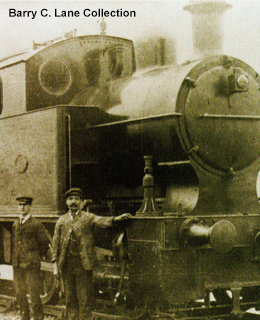
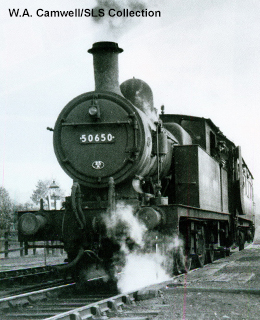
The principal feat of engineering was the construction of the 1,500ft long viaduct across the Don valley and the river Don at Conisborough. Over 11 million bricks and 2,000 tons of cement were used to build it.
Construction was completed in 1908 and goods traffic, mainly coal started. The first passenger traffic started on 3rd June 1912 running between Wakefield Westgate and Edlington with intermediate stops at Ryhill, Grimethorpe, Great Houghton, Goldthorpe, Thrurnscoe, Harlington and Denaby. Trains were operated on behalf of the DVR by the Lancashire & Yorkshire Railway.
On the 1st January 1923 our railway was taken over by the London, Midland & Scottish Railway (LMS), unfortunately passenger traffic ceased on the 10th September 1951, the line was still used for goods traffic until the early 1990’s when the need for coal slumped and the transportation was taken over by road haulage.
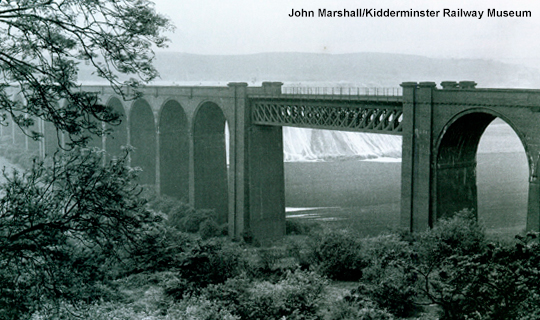
The Dumping Ground
On the 22nd October 2013 the BBC sent round an investigative team to film the fly tipping that was occurring on the old railway line at Goldthorpe. The report was damming, showing the site as a filthy, fly and rat-infested dump where people simply threw any items they didn’t want over the railway bridge at Straight Lane down onto the old track bed.
Two years previously Network Rail had spent over £65,000 to clear the site but in just two years the filth was back again and it was clear that Network Rail could not sustain the level of investment required to continually clear it up.


Painting the Bridges
Barnsley Metropolitan Borough Council (BMBC), the Goldthorpe Development Group and local residents took action, starting with painting four of the railway bridges which improved the look of the area and installing CCTV and fencing which reduced the fly-tipping.
The Goldthorpe Railway Embankment Group (GREG), was created to explore if the cuttings could be further improved and reimagined by the community as a neighbourhood resource for natural beauty where local people could walk freely and safely amongst trees, shrubs and wildlife and also an area for environmental education.
In 2016 GREG commissioned students from Sheffield School of Architecture to creatively deliver community consultation. This helped bring the community together for a common cause and started the first project on the site.
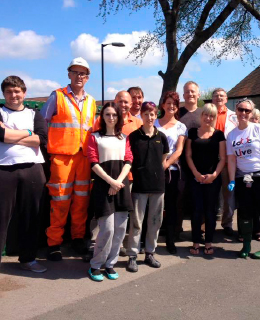

Pathways
In March 2021 we managed to obtain enough funding to create a better pathway running the full length of the site. The company chosen was one that had done work on the Trans Pennine Trail and was chosen for the ‘soft feel’ to the finish of the pathway. The pathway is a delight to walk on as it feels almost spongy and soft, yet it is very strong.
The team only took a couple of weeks to prepare the ground all the way from the Straight Lane bridge up to the top entrance. The muddy condition of the lower site made the work extremely difficult but it has turned out well, we have ‘passing loops’ for wheelchairs and everybody who uses it says it’s a great job.
The benches and litter bins were also fitted around the same time, allowing visitors the chance to take a breather whist enjoying the lovely views over the site as a whole.

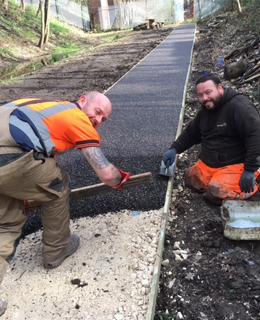
Site Usage
School Transition Days: where primary school children meet their counterparts from other primaries all heading towards the ‘big school’.
School planting days: Primary and secondary school children are invited to help us plant trees and shrubs.
Mural painting; helping create the mural on the old railway bridge wall.
Autumn Fair: Hundreds of people popped down for a day of fun and exploration, with pumpkin decoration, local traders selling goods for Christmas, hunt the pumpkin, loads to do and so well attended by hundreds of local people.
Churches together: Friends and families get together over a warm fire pit, children play, it’s a lovely day out.
Poppies 21, Guides, Scouts, Beavers, people simply walking in. Our site is now open for the community and we will advertise when in a better fashion very shortly.
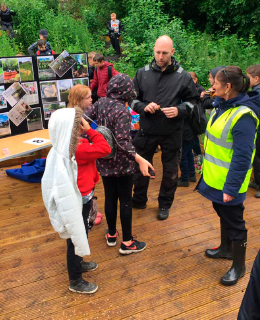
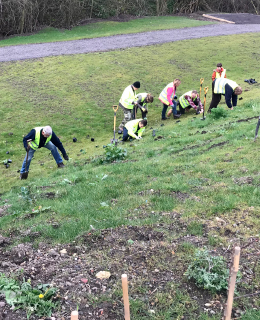
The Future
We are trying hard to recognise how our site can help the community in general as well a specific ways. We hope this web site will allow people to let us know what they want out of the site and hopefully we will be able to give it.
Our current plans include improving the embankment with more shrubs and flowers, expand the planting down towards the lower site so we have lovely displays throughout the year. Plant up the lower site with shade loving plants that will survive down there.
We are also looking at how we can expand our reach through the fence to the ASDA Bridge. Our first task is to remove the fly tipping from that area, another daunting task but one where we will rise to the challenge.
This is a community site, for use by the community for the community.
The GREG team are merely custodians of the site, it really does belong to the community as a whole.